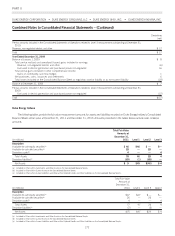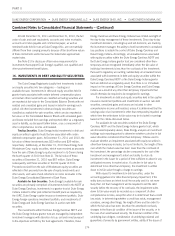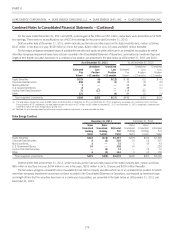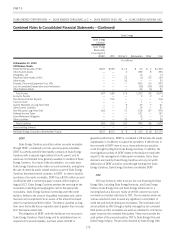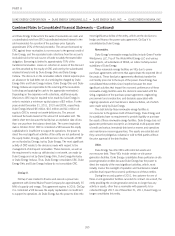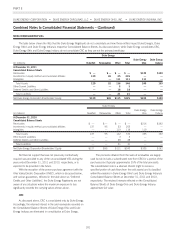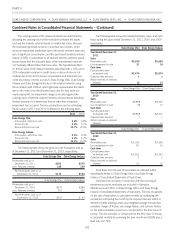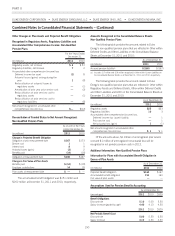Duke Energy 2011 Annual Report Download - page 200
Download and view the complete annual report
Please find page 200 of the 2011 Duke Energy annual report below. You can navigate through the pages in the report by either clicking on the pages listed below, or by using the keyword search tool below to find specific information within the annual report.
PART II
DUKE ENERGY CORPORATION •DUKE ENERGY CAROLINAS, LLC •DUKE ENERGY OHIO, INC. •DUKE ENERGY INDIANA, INC.
Combined Notes to Consolidated Financial Statements – (Continued)
and Duke Energy Indiana from the sales of receivables are cash and
a subordinated note from CRC (subordinated retained interest in the
sold receivables) for a portion of the purchase price (typically
approximates 25% of the total proceeds). The amount borrowed by
CRC against these receivables is non-recourse to the general credit of
Duke Energy, and the associated cash collections from the accounts
receivable sold is the sole source of funds to satisfy the related debt
obligation. Borrowing is limited to approximately 75% of the
transferred receivables. Losses on collection in excess of the discount
are first absorbed by the equity of CRC and next by the subordinated
retained interests held by Duke Energy Ohio and Duke Energy
Indiana. The discount on the receivables reflects interest expense plus
an allowance for bad debts net of a servicing fee charged by Duke
Energy Ohio and Duke Energy Indiana. Duke Energy Ohio and Duke
Energy Indiana are responsible for the servicing of the receivables
(collecting and applying the cash to the appropriate receivables).
Depending on the experience with collections, additional equity
infusionstoCRCmayberequiredtobemadebyDukeEnergyin
order to maintain a minimum equity balance of $3 million. For the
years ended December 31, 2011, 2010 and 2009, respectively,
Duke Energy infused $6 million, $10 million and $11 million of
equity to CRC to remedy net worth deficiencies. The amount
borrowed fluctuates based on the amount of receivables sold. The
debt is short term because the facility has an expiration date of less
than one year from the balance sheet date. The current expiration
date is October 2012. CRC is considered a VIE because the equity
capitalization is insufficient to support its operations, the power to
direct the most significant activities of the entity are not performed by
the equity holder, Cinergy, and deficiencies in the net worth of CRC
are not funded by Cinergy, but by Duke Energy. The most significant
activity of CRC relates to the decisions made with respect to the
management of delinquent receivables. These decisions, as well as
the requirement to make up deficiencies in net worth, are made by
Duke Energy and not by Duke Energy Ohio, Duke Energy Kentucky
or Duke Energy Indiana. Thus, Duke Energy consolidates CRC. Duke
Energy Ohio and Duke Energy Indiana do not consolidate CRC.
CinCap V.
CinCap V was created to finance and execute a power sale
agreement with Central Maine Power Company for approximately 35
MW of capacity and energy. This agreement expires in 2016. CinCap
V is considered a VIE because the equity capitalization is insufficient
to support its operations. As Duke Energy has the power to direct the
most significant activities of the entity, which are the decisions to
hedge and finance the power sales agreement, CinCap V is
consolidated by Duke Energy.
Renewables.
Duke Energy’s renewable energy facilities include Green Frontier
Windpower, LLC, Top of The World Wind Energy LLC and various
solar projects, all subsidiaries of DEGS, an indirect wholly-owned
subsidiary of Duke Energy.
These renewable energy facilities are VIEs due to power
purchase agreements with terms that approximate the expected life of
the projects. These fixed price agreements effectively transfer the
commodity price risk to the buyer of the power. Duke Energy has
consolidated these entities since inception because the most
significant activities that impact the economic performance of these
renewable energy facilities were the decisions associated with the
siting, negotiation of the purchase power agreement, engineering,
procurement and construction, and decisions associated with
ongoing operations and maintenance related activities, all of which
were made solely by Duke Energy.
The debt held by these renewable energy facilities is
non-recourse to the general credit of Duke Energy. Duke Energy and
its subsidiaries have no requirement to provide liquidity or purchase
the assets of these renewable energy facilities. Duke Energy does not
guarantee performance except for an immaterial multi-purpose letter
of credit and various immaterial debt service reserve and operations
and maintenance reserve guarantees. The assets are restricted and
they cannot be pledged as collateral or sold to third parties without
the prior approval of the debt holders.
Other.
Duke Energy has other VIEs with restricted assets and
non-recourse debt. These VIEs include certain on-site power
generation facilities. Duke Energy consolidates these particular on-site
power generation entities because Duke Energy has the power to
direct the majority of the most significant activities, which, most
notably involve the oversight of operation and maintenance related
activities that impact the economic performance of these entities.
During the second quarter of 2011, the customer for one of
these on-site generation facilities canceled its contract. As a result, the
entity providing the on-site generation services no longer has any
activity or assets, other than a receivable with payments to be
collected through 2017. As of December 31, 2011, Duke Energy no
longer consolidates this entity.
180




